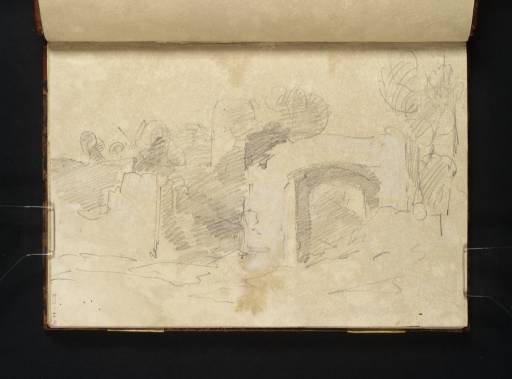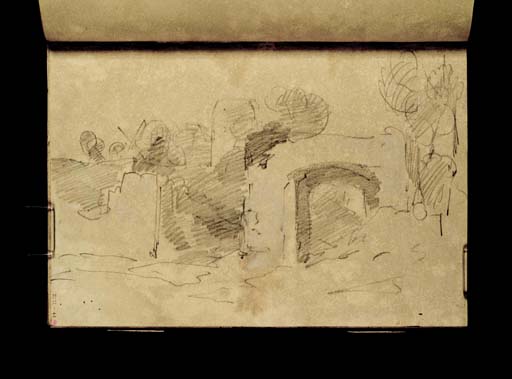Joseph Mallord William Turner The Pipewell Gate, Winchelsea c.1806-10
Image 1 of 2
Joseph Mallord William Turner,
The Pipewell Gate, Winchelsea
c.1806-10
Joseph Mallord William Turner 1775–1851
Folio 6 Recto:
The Pipewell Gate, Winchelsea circa 1806–10
D05763
Turner Bequest XCII 44
Turner Bequest XCII 44
Pencil and white chalk on cream wove paper, prepared with a buff wash, 153 x 216 mm
Inscribed by John Ruskin in red ink ‘44’ bottom left, descending vertically
Stamped in black ‘XCII 44’ bottom left, descending vertically
Blind-stamped with the Turner Bequest monogram lower right of centre
Inscribed by John Ruskin in red ink ‘44’ bottom left, descending vertically
Stamped in black ‘XCII 44’ bottom left, descending vertically
Blind-stamped with the Turner Bequest monogram lower right of centre
Accepted by the nation as part of the Turner Bequest 1856
Exhibition history
1998
Turner in 1066 Country, Hastings Museum and Art Gallery, September–November 1998 (35, as ‘f.54a–55’).
.
References
1909
A.J. Finberg, A Complete Inventory of the Drawings of the Turner Bequest, London 1909, vol.I, p.240, XCII 44, as ‘East gate, Winchelsea’.
1974
Gerald Wilkinson, The Sketches of Turner, R.A. 1802–20: Genius of the Romantic, London 1974, p.70 reproduced in colour.
1998
Eric Shanes, Turner in 1066 Country, exhibition catalogue, Hastings Museum and Art Gallery 1998, p.22, as ‘study of the East Gate, Winchelsea’.
1996
Gillian Forrester, Turner’s ‘Drawing Book’: The Liber Studiorum, exhibition catalogue, Tate Gallery, London 1996, p.103.
2008
Gillian Forrester, David Hill, Matthew Imms and others, Reisen mit William Turner: J.M.W. Turner: Das Liber Studiorum, exhibition catalogue, Galerie Stihl, Waiblingen 2008, p.172.
As Finberg observed, this is the origin of the view of this subject entitled ‘East Gate, Winchelsea’ in the Liber Studiorum; for Turner’s drawing for the Liber plate see Tate D08167; Turner Bequest CXVIII M. Turner took another Winchelsea subject for the Liber from folio 11 of this sketchbook (D05762; Turner Bequest XCII 43), and as Gillian Forrester suggests, probably worked up the designs as a contrasting pair, pastoral in the present case and military in the other for which his working title was ‘Soldiers’.
Turner’s title for the Liber plate based on the present drawing would indicate the Strand Gate leading into Winchelsea from the Rye road, the identification generally accepted today. However, the drawings and plates seem to show a different structure and surroundings. As discussed more extensively by Matthew Imms in his catalogue notes for the drawings made specifically for the Liber, the gate lacks the round corner towers of the Strand Gate and looks more like the plainer Pipewell (or Land or Ferry) Gate at the top of Ferry Hill at the north-west corner of the town. Turner shows a windmill, probably St Leonard’s Mill that formerly stood on the hill of Iham; see also folio 4 (D05722). More problematical is the tower at left of the gate, seen in folio 11 and in both Liber plates, which cannot be accounted for today in relation to either the Pipewell or Strand Gates. It might indicate the castle said to have stood nearby or the remains of the church of St Leonard, now vanished but part of which was extant at least into the 1790s. The Liber compositions are much romanticised while the supposedly on-the-spot drawings in the sketchbook might also contain some artistic licence.
Turner’s title for the Liber plate based on the present drawing would indicate the Strand Gate leading into Winchelsea from the Rye road, the identification generally accepted today. However, the drawings and plates seem to show a different structure and surroundings. As discussed more extensively by Matthew Imms in his catalogue notes for the drawings made specifically for the Liber, the gate lacks the round corner towers of the Strand Gate and looks more like the plainer Pipewell (or Land or Ferry) Gate at the top of Ferry Hill at the north-west corner of the town. Turner shows a windmill, probably St Leonard’s Mill that formerly stood on the hill of Iham; see also folio 4 (D05722). More problematical is the tower at left of the gate, seen in folio 11 and in both Liber plates, which cannot be accounted for today in relation to either the Pipewell or Strand Gates. It might indicate the castle said to have stood nearby or the remains of the church of St Leonard, now vanished but part of which was extant at least into the 1790s. The Liber compositions are much romanticised while the supposedly on-the-spot drawings in the sketchbook might also contain some artistic licence.
The Liber plate of this subject was published in 1819 and Gerald Wilkinson, while retaining Finberg’s dating of the sketchbook to 1804–6, stated that he could not see the reason for it.
Finberg recorded that this was one of four leaves from the sketchbook ‘found loose’.
The leaf is stained.
The leaf is stained.
Verso:
Blank, inscribed by John Ruskin in red ink ‘150. I’
David Blayney Brown
April 2010
How to cite
David Blayney Brown, ‘The Pipewell Gate, Winchelsea c.1806–10 by Joseph Mallord William Turner’, catalogue entry, April 2010, in David Blayney Brown (ed.), J.M.W. Turner: Sketchbooks, Drawings and Watercolours, Tate Research Publication, December 2012, https://www


